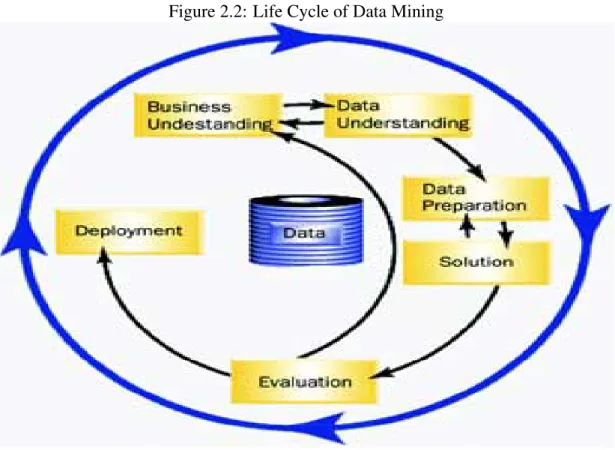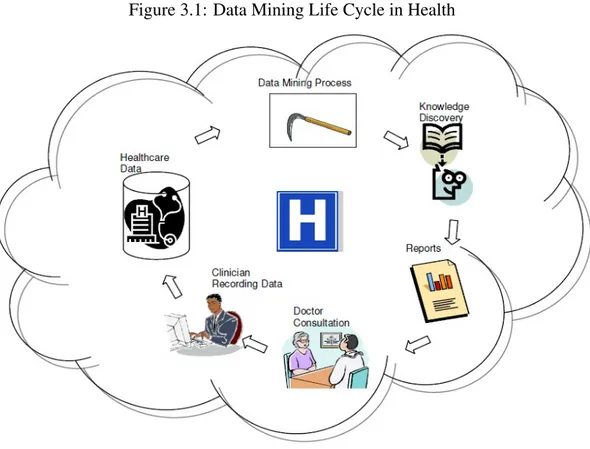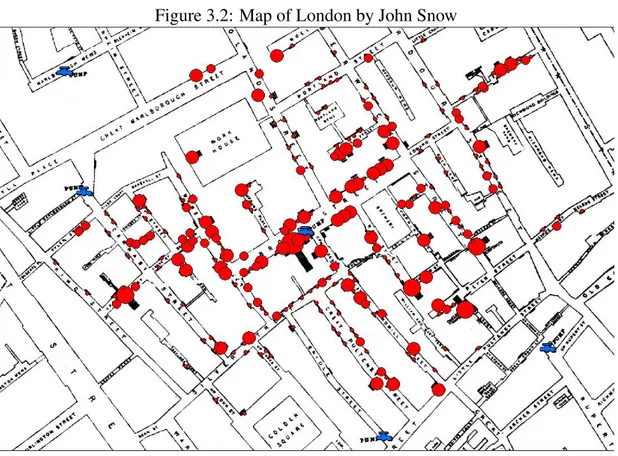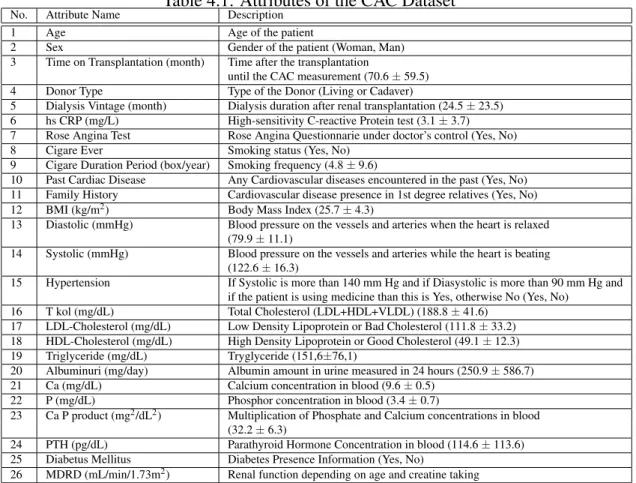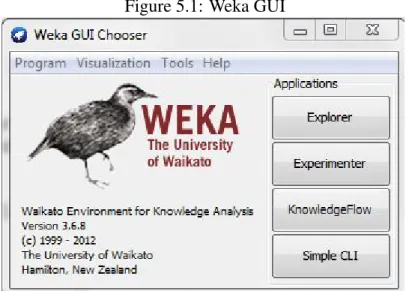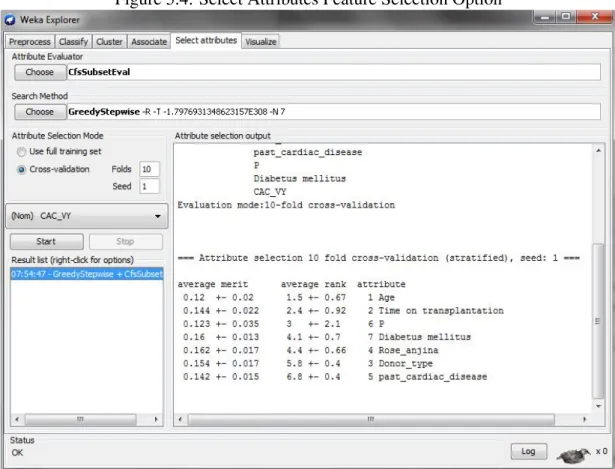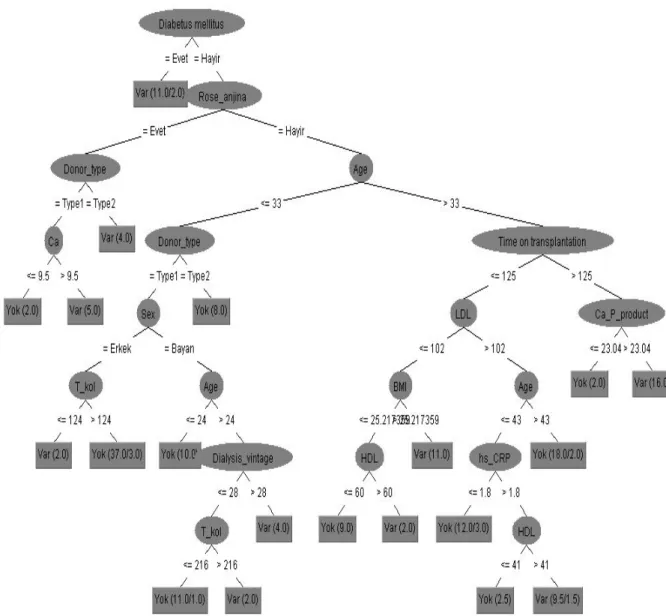KADIR HAS UNIVERSITY
GRADUATE SCHOOL OF SCIENCE AND ENGINEERING
Feature Selection and Discretization
For Improving Classification Performance
on CAC Data Set
KAMRAN EMRE SAYIN
KADIR HAS UNIVERSITY
GRADUATE SCHOOL OF SCIENCE AND ENGINEERING
Feature Selection and Discretization
For Improving Classification Performance
on CAC Data Set
KAMRAN EMRE SAYIN
Thesis Committee
Prof.Dr. Hasan DA ˘G (Supervisor) :Asst. Prof. Dr. Song¨ul ALBAYRAK:
Asst. Prof. Dr. ¨Oznur YAS¸AR:
Abstract
Data Mining usage in Health Sector increased much in this decade because of the need for efficient treatment. From cost-cutting in medical expenses to acting as a Decision Support System for patient diagnosis, Data Mining nowadays is a strong companion in Health Sector. The dataset used in this thesis belongs to Dr. Nurhan Seyahi. Dr. Nurhan Seyahi and his colleagues made a research about Coronary Artery Calcification in 178 patients having renal transplantation recently. They used conventional statistical methods in their research. By using the power of data mining, this thesis shows the importance of feature selection and discretization used with classification methods for acting as a decision support system in patient diagnosis for CAC Dataset. Just by looking at seven important attributes, which are; age, time of transplantation, diabetes mellitus, phosphor, rose angina test, donor type and patient history, doctors can decide whether the patient has coronary artery calcification or not with approximately 70% accuracy. After the discretization process this accuracy approximately increases to 75% in some algorithms. Thus becoming a strong decision support system for doctors working in this area.
¨
Ozet
Veri Madencili˘gi’nin sa˘glık alanında kullanımı son 10 yılda verimli tedavi ihtiyacı dolayısıyla artmıs¸tır. Veri Madencili˘gi g¨un¨um¨uzde sa˘glık alanında g¨uc¸l¨u bir yardımcıdır. Sa˘glık harcamalarının kesilmesinden, hasta tes¸hisinde karar destek sistemi olarak rol almasına kadar uzanır. Bu tezde kullanılan verisetinin sahibi Dr. Nurhan Seyahi’dir. Dr. Nurhan Seyahi ve meslektas¸ları 178 tane b¨obrek nakli gec¸irmis¸ hastalarda Ko-roner Arterlerde Kalsifikasyon ¨uzerine aras¸tırma yapmıs¸lardır. Onlar aras¸tırmalarında geleneksel istatistik metodlarını kullanmıs¸lardır. Bu tez, veri madencili˘ginin g¨uc¨un¨u kullanarak, ¨oznitelik sec¸me ve ayrıklas¸tırma metodlarıyla beraber sınıflandırma algo-ritmalarının kullanılmasıyla Koroner Arterlerde Kalsifikasyon olup olmadı˘gınının in-celenmesinin ¨onemini g¨ostermektedir. Sadece yedi ¨ozniteli˘ge bakarak, ki bunlar; yas¸, nakil s¨uresi, diabet, fosfor, rose anjina testi, verici tipi ve hastanın hastalık gec¸mis¸i ol-mak ¨uzere, doktorlar hastada koroner arterlerde kalsifikasyon olup olmadı˘gına yaklas¸ık 70% do˘grulukta karar verebilirler. Veri ayrıklas¸tırma is¸leminden sonra bu bas¸arı oranı bazı algoritmalarda 75% civarlarına y¨ukselir. Bu nedenle bu alanda c¸alıs¸an doktorlar ic¸in kuvvetli bir karar destek sistemi olur.
Acknowledgements
Thanks to my mother, Hasibe Halise Sayın who acted as a light to guide me through my life. She is my friend, my co-worker, my all.
Thanks to my father Adnan Sayın and my grandmother Cevheret C¸ eltikcilio˘glu, their sprits were all around me. I’m really grateful to Kamran ˙Inan for his support during my educational career and for his guidance to improve my vision.
In the end I would like to thank Prof. Dr. Hasan Da˘g and Is¸ıl Yenido˘gan. They are the only reason for me to study the field of Data Mining. They let me in to their Data Mining Group and gave great contributions and also thanks to Assistant Professor Song¨ul Albayrak for teaching me the Introduction to Data Mining course and for all her help in Data Mining conference papers.
Table of Contents
Abstract iii
Acknowledgements v
Table of Contents vi
List of Tables viii
List of Figures ix
1 Introduction 1
2 Data Mining 3
2.1 Application Areas of Data Mining . . . 4
2.2 Tasks of Data Mining . . . 5
3 Data Mining in Health Sector 6 4 CAC Dataset 9 4.1 Attributes of the Data Set . . . 9
5 Algorithms Used For Data Mining 11 5.1 Feature Selection Algorithms . . . 12
5.1.1 Information Gain . . . 14
5.1.2 Gain Ratio . . . 15
Ranker . . . 15
5.1.3 Correlation based Feature Selection . . . 15
Greedy Stepwise Search Algorithm . . . 15
5.2.1 J48 . . . 15
5.2.2 Rep Tree . . . 16
5.2.3 Random Tree . . . 16
5.2.4 Naive Bayes . . . 16
5.2.5 Sequential Minimal Optimization . . . 17
5.2.6 Multilayer Perceptron . . . 17
5.3 Discretization . . . 17
6 Preprocessing and Test Results 19 6.1 Benchmark of Classification Algorithms Applied to the Original Dataset 19 6.2 Feature Selection Algorithms Applied . . . 21
6.2.1 Benchmark of Classification Algorithms after Feature Selection 23 6.3 Discretization Applied . . . 26 6.3.1 Benchmarks of Classification Algorithms after Discretization 29
7 Conclusion 31
References 33
List of Tables
4.1 Attributes of the CAC Dataset . . . 10 6.1 Accuracy Performance of Classification Algorithms on Original Dataset 19 6.2 Attributes Selected with Information Gain . . . 22 6.3 Attributes Selected with Gain Ratio . . . 22 6.4 Attributes Selected with CFS . . . 23 6.5 Similarity of Selected Attributes among Feature Selection Algorithms
(IG, GR, CFS) . . . 23 6.6 Accuracy Performance of Classification Algorithms on 7 Attributes
Dataset . . . 23 6.7 Accuracy Performance of Classification Algorithms After
List of Figures
2.1 Data Mining is the Combination of Many Fields . . . 3
2.2 Life Cycle of Data Mining . . . 4
3.1 Data Mining Life Cycle in Health . . . 6
3.2 Map of London by John Snow . . . 7
5.1 Weka GUI . . . 11
5.2 Experimenter . . . 12
5.3 Preprocess Feature Selection Option . . . 13
5.4 Select Attributes Feature Selection Option . . . 14
6.1 J48 Tree of 7 Attributes Dataset . . . 20
6.2 REPTree of 26 Attributes Dataset . . . 21
6.3 J48 Tree of 7 Attributes Dataset . . . 24
6.4 REPTree of 7 Attributes Dataset . . . 25
6.5 Selecting Discretization from Preprocess Tab . . . 26
6.6 Discretization Options in Weka . . . 27
6.7 View of The Dataset After Discretization . . . 28
6.8 Discretized J48 Tree of Reduced Dataset with 7 Attributes . . . 29
List of Abbreviations
ARFF Attribute Relation File Format Ca Calcium
CAC Coronary Artery Calcification DM Data Mining
KL Kullback-Leibler MLP Multi Layer Perceptron NB Naive Bayes
P Phosphor
SMO Sequential Minimal Optimization SVM Support Vector Machine
Chapter 1
Introduction
Improvements in data storage capacity and the introduction of large databases paved the way for another concept which is data warehouses. These data warehouses contain enormous amounts of data but huge amounts of data do not necessarily mean valuable information by itself. Data Mining is the extraction of valuable information from the patterns of data and turning it into useful knowledge.
Data mining uses the power of conventional statistical methods, decision trees, neu-ral networks and other areas. Most important factor in data mining is field expert supported decision making. Data mining methods are only used as a decision support system, so at least one expert at the field of the data set used is required for an accurate work.
There are several application areas of Data Mining, one of them is healthcare. This thesis uses a medical data set which was formed by Dr. Nurhan Seyahi and his col-leagues. They examined coronary artery calcification and the important features that contribute to this disease in renal transplant patients.
Aim of this thesis is to build an efficient decision support system for doctors working on CAC Presence in renal transplant patients. Doctors will spend their time less during diagnosis phase and cost of tests will be reduced by reducing the number of neces-sary tests. First step is to apply classification rules and see the classification accuracy performance.
Second step is to find the most valuable attributes to decrease the number of tests made and increase the classification accuracy performances. Third step is to use dis-cretization for easier interpretation of numerical attributes turning into nominal (cat-egorical) ones and increasing the classification accuracy of tree and rule based algo-rithms that depend on nominal data. So our methodology is to learn about the dataset, apply classification algorithms, apply feature selection algorithms then apply classi-fication algorithms and in the end use discretization algorithms on the dataset before applying one last classification algorithms to see the benchmarks and improvements.
The second chapter explains the aspects of Data Mining and its application areas. Answers what differs Data Mining from ordinary Statistics and other conventional methods.
Third chapter goes into detail of Data Mining, used in Health Sector nowadays and how it all started.
Fourth chapter explains Dr. Nurhan Seyahi’s Coronary Artery Calcification Dataset, how it is formed and the attributes inside the dataset.
Fifth chapter dives into Data Mining Algorithms used in this thesis. Starting from feature selection algorithms, going to classification algorithms and ending with the discretization process.
Sixth chapter shows the test results and discusses them at the end of each experiment.
The final chapter is the conclusion, explains what is gained from the work and what can be done as a future work.
Chapter 2
Data Mining
Data Mining is the process of gathering implicit information from a dataset and extracting this hidden information to provide useful explicit information in the end [1]. It is a collection of statistical methods, mathematical algorithms, decision trees, artificial neural networks, support vector machines, clustering methods. On top of that it directly stands on the vision of a field expert. That is why it is generally used as a Decision Support System [2].
Combination of many fields that form and contribute to the Data Mining is shown in figure 2.1. Statistics, artifical intelligence, visualization, machine learning, pattern recognition and other fields unite to form data mining. They are not individually Data Mining alone.
Data Mining is not Data Warehousing, simple SQL, Software Agents, Online Ana-lytical Processing (OLAP), Statistical Analysis Tool or Data visualization.
Life cycle of Data Mining consisting of business understanding (objectives), data understanding, data preparation, modeling (solution), evaluation and deployment can be seen in figure 2.2[3].
Figure 2.2: Life Cycle of Data Mining
Without one phase to be completed perfectly other phases cannot be initiated cor-rectly.
2.1 Application Areas of Data Mining
Today, Data Mining is used in different areas with different purposes. • Insurance Companies for calculating the risk factors.
• Banks for managing loan ratios and fraud detection.
• Marketing Companies for deciding which item is sold with which item. • Weather prediction and other climate related future events.
• Health sector for reducing costs and making efficient diagnosis.
2.2 Tasks of Data Mining
Data Mining tasks can be divided into four main categories. • Classification and Prediction.
• Association Rules. • Clustering Analysis. • Outlier Detection.
Chapter 3
Data Mining in Health Sector
Just like data mining used in other fields, data mining in health has a similar method-ology for a life cycle shown in figure 3.1[4].
The only difference is the importance of the field. Always remembering that data mining is not a final verdict just a decision support system to ease the life of doctors. Understanding the objective is the most important part of the lifecycle.
In 1854 John Snow saved people from a massive cholera outbreak in Soho, London by mapping the locations of the deaths on a map and found they clustered around a pump. This was one of the ealiest usage of Data Mining in Health. His map is shown in figure 3.2 [5].
Figure 3.2: Map of London by John Snow
Karaolis and his friends applied data mining method C4.5 to 528 patients having coronary heart diseases to show that the important factors for myocardial infarction (MI); is age, smoking, family history, and for percutaneous coronary intervention (PCI); is the family story, hypertension and diabetes, for coronary large veins bypass (CABG); is age, hypertension and smoking [6].
Karaolis and his friends worked on the case with 620 patients using C4.5 decision tree algorithm finding the most important risk factors are; gender, age, smoking, blood pressure and cholesterol [7].
The team of Srinivas made a research about a coal mine in India named Singareni to compare the cardiovascular diseases in this region with other regions, taking the other attributes into account [8].
In another work, Rothaus and his friends made a research about heart rate distur-bances using K-means algorithm to assess which attributes are useful in classifying heart rate order [9].
In China, Xing and his colleagues worked on the survival rates of patients having coronary heart diseases, using 1000 patients and monitoring them for 6 months. 502 of the patients formed a dataset and they applied 3 different Data Mining algorithms on this dataset. [10]
Also in China, Z. Lin and his colleagues studied to produce an association rule depending on the support confidence. They saw that the correlation of the model before and after the rule applied did not match each other [11].
Chapter 4
CAC Dataset
The 178 records from the dataset which are used in this thesis were gathered from outpatients in ˙Istanbul University Cerrahpas¸a Medical Faculty between March 2006 and December 2007. This dataset is published in the work [12] by Dr. Nurhan Seyahi and his colleagues.
Dataset consists of 26 attributes, having 8 categorical and 18 numerical attributes. Class information can take two values which are; ”CAC Present” and ”CAC Absent”
4.1 Attributes of the Data Set
Details of the attributes in the dataset containing 178 patients having renal trans-plantation is given in table 4.1
Table 4.1: Attributes of the CAC Dataset
No. Attribute Name Description 1 Age Age of the patient
2 Sex Gender of the patient (Woman, Man) 3 Time on Transplantation (month) Time after the transplantation
until the CAC measurement (70.6 ± 59.5) 4 Donor Type Type of the Donor (Living or Cadaver)
5 Dialysis Vintage (month) Dialysis duration after renal transplantation (24.5 ± 23.5) 6 hs CRP (mg/L) High-sensitivity C-reactive Protein test (3.1 ± 3.7) 7 Rose Angina Test Rose Angina Questionnarie under doctor’s control (Yes, No) 8 Cigare Ever Smoking status (Yes, No)
9 Cigare Duration Period (box/year) Smoking frequency (4.8 ± 9.6)
10 Past Cardiac Disease Any Cardiovascular diseases encountered in the past (Yes, No) 11 Family History Cardiovascular disease presence in 1st degree relatives (Yes, No) 12 BMI (kg/m2) Body Mass Index (25.7 ± 4.3)
13 Diastolic (mmHg) Blood pressure on the vessels and arteries when the heart is relaxed (79.9 ± 11.1)
14 Systolic (mmHg) Blood pressure on the vessels and arteries while the heart is beating (122.6 ± 16.3)
15 Hypertension If Systolic is more than 140 mm Hg and if Diasystolic is more than 90 mm Hg and if the patient is using medicine than this is Yes, otherwise No (Yes, No)
16 T kol (mg/dL) Total Cholesterol (LDL+HDL+VLDL) (188.8 ± 41.6) 17 LDL-Cholesterol (mg/dL) Low Density Lipoprotein or Bad Cholesterol (111.8 ± 33.2) 18 HDL-Cholesterol (mg/dL) High Density Lipoprotein or Good Cholesterol (49.1 ± 12.3) 19 Triglyceride (mg/dL) Tryglyceride (151,6±76,1)
20 Albuminuri (mg/day) Albumin amount in urine measured in 24 hours (250.9 ± 586.7) 21 Ca (mg/dL) Calcium concentration in blood (9.6 ± 0.5)
22 P (mg/dL) Phosphor concentration in blood (3.4 ± 0.7)
23 Ca P product (mg2/dL2) Multiplication of Phosphate and Calcium concentrations in blood
(32.2 ± 6.3)
24 PTH (pg/dL) Parathyroid Hormone Concentration in blood (114.6 ± 113.6) 25 Diabetus Mellitus Diabetes Presence Information (Yes, No)
Chapter 5
Algorithms Used For Data Mining
Data mining algorithms are used to process the data into valuable information. Based on the objective of mining they are basically divided into four categories.
The algorithms used in this thesis are from Weka [13]. Weka is an open-source software developed at the University of Waikato and the programming language is based on Java.
Weka has 4 different applications, Explorer, Experimenter, KnowledgeFlow and Simple CLI. Knowledge Flow is a node and linked based interface and Simple CLI is the command line prompt version where each algorithm is run by hand. Below in figure 5.1 is a screenshot of the program.
In this thesis only Explorer and Experiment applications of the Weka are used. Be-low in figure 5.2 the Experimenter interface is shown.
Figure 5.2: Experimenter
5.1 Feature Selection Algorithms
Feature Selection Algorithms choose the best set of features that contribute to the class value, that is attributes that are more important are considered in the selection. Three types of Feature Selection Algorithms are used in this thesis, Information Gain, Gain Ratio and Correlation Based Feature Selection (CFS) algorithms.
Feature Selection can only be done from the Explorer interface. It can be done either from the Preprocess tab which is shown in figure 5.3.
or from the Select Attributes tab shown in figure 5.4. Here average merit and aver-age rank for each attribute is shown also unlike the preprocess tab’s usaver-age for feature selection algorithms.
Figure 5.4: Select Attributes Feature Selection Option
5.1.1 Information Gain
First proposed by Kullback and Leibler [14], information gain calculates the infor-mation gathered from entropy measurement of the given attribute with respect to the class.
In f o Gain(Class, Attribute) = H( Class ) − H( Class | Attribute ). (5.1) here H is the entropy. It is defined as;
H(x) = −
n
∑
i=1
p(xi) log2p(xi). (5.2)
here p shows the probability of a particular value occuring and x is the sample (record) space.
5.1.2 Gain Ratio
Gain Ratio is simply the normalized version of Information Gain algorithm. It re-duces the bias of Information Gain, dividing by the entropy of the given attribute.
Gain Ratio(Class, Attribute) = H( Class ) − H( Class | Attribute )
H(Attribute) . (5.3)
Ranker
Information Gain and Gain Ratio algorithms both use the ranker method as searching type. The attributes are ranked with respect to the average merit and average rank. An option to assign a cut off point (by strictly assigning number or a threshold value) to select spesific number of attributes is available [15].
5.1.3 Correlation based Feature Selection
CFS is a feature subset selection algorithm found by Mark Hall in 1999 [16] in his PhD study. This feature selection algorithm looks for the best subset of attributes holding the highest correlation with the class attribute but lowest correlation between each attribute.
Greedy Stepwise Search Algorithm
This search algorithm can be used with any feature subset selection algorithm. I used Greedy Stepwise Search Algorithm in conjunction with CFS algorithm to search for the best subset of attributes [17]. ”It performs greedy forward search from an empty set of attributes or greedy backward search from full set of attributes. It adds/deletes at-tributes to the set until no longer any other atat-tributes changes the evaluation performance”[18]. There is also an option to rank the attributes and use a cutoff point (by number of at-tributes or by a threshold value) to select the atat-tributes, which I used in this thesis.
5.2 Classification Algorithms
Classification is the process assigning an appropriate class label to an instance (record) in the dataset [19]. Classification is generally used in supervised datasets where there is a class label for each instance.
5.2.1 J48
the splitting criteria. Has both reduced error pruning and normal C4.5 pruning option. As a default it comes with C4.5 pruning option, which is used in this thesis.
5.2.2 Rep Tree
Builds a decision tree (if the class is nominal) or regression tree (if the class is nu-merical) using information gain and variance respectively and prunes it using reduced-error pruning [21]. Reduced Error Pruning is the pruning of a node from bottom to top, looking for replacements with the most frequent class, if the misclassification rises than the node is unpruned otherwise if there is no rise in misclassification errors, then the node is pruned. In the REPTree numerical values are sorted only once for each numerical attribute The sorting process is for determining split points on numeric attributes.The tree is built in a greedy fashion, with the best attribute chosen at each point according to info-gain. [18]
5.2.3 Random Tree
Constructs a decision tree that regards K randomly chosen features at each node. No type of pruning is done. Random Tree can only work with nominal classes and binary classes [18]. Generally used as a base for building Random Forests. [22]. K value is left as 0 in our work which sets the number of randomly chosen attributes. which
log2(number o f attributes) = K (5.4) so the number of features to be considered becomes 1.
5.2.4 Naive Bayes
Naive Bayes is a probabilistic approach to classification problem[23]. The differ-ence from the conventional Bayes theorem is that, it assumes all atributes are indepen-dent and not affected by each other that is where the ”Naive” word comes.
P(C, X ) = P( X | C ) − P( C )
P(X ) . (5.5)
Here X is the sample containing the attributes and C is the value of the Class at-tribute.
5.2.5 Sequential Minimal Optimization
Sequential Minimal Optimization is a Support Vector Machine based algorithm, de-veloped by John Platt [24] at Microsoft technologies. It is generally used in solving optimization problems during the training process of Support Vector Machines. SMO replaces all missing values and turns categorical (nominal) attributes into binary at-tributes. It also normalizes all attributes by default. In this thesis it is options are used in default mode, with PolyKernel as the kernel selection and filter type as Normalize training data. SMO works better on numerical attributes.
5.2.6 Multilayer Perceptron
MLP is a type of Artifical Neural Network depending on neurons (nodes) [25]. MLP is a feedforward and backpropagation algorithm. Consists of multilevels with each layer fully connected to the next one. . MLP utilizes a supervised learning technique called backpropagation for classifying instances. In Weka it uses a sigmoid activation function and has options for an independent GUI usage to monitor the training phase [18]. MLP is introduced to solve the limitations of perceptrons which could solve only linearly seperable problems [26].
5.3 Discretization
Discretization is simply the transformation of numerical values to nominal (cate-gorical) values. This process is done by dividing a continuous range into subgroups. Suppose there are 200 people in a group that want to apply for a bank loan and their ages are between 20 and 80. If the bank workers want to categorize them, they have to put them into some groups. For example one can categorize people between 20 and 40 as young, people between 40 and 65 as middle aged and 65 to 80 as old. So there will be three subgroups, which are; young, middle-aged and old. This subgroups can be increased depending on the choice of the field expert. This makes it easy to understand and easy to standardise.
Discretization can be grouped into two categories, Unsupervised Discretization and Supervised Discretization. As the name implies Unsupervised Discretization is gen-erally applied to datasets having no class information. The types of Unsupervised Discretization are;
• Equal Width Binning • Equal Frequency Binning
Supervised Discretization techniques as the name suggests takes the class informa-tion into account before making subgroups. Supervised methods are mainly based on Fayyad-Irani [28] or Kononenko [29] algorithms.
Weka uses Fayyad-Irani method as default, so in my thesis I used Fayyad-Irani Dis-cretization method with better encoding option.
Chapter 6
Preprocessing and Test Results
As implied before, one of the goals of this work is to apply classification algorithms to CAC dataset for classifying future instances and make a set of rules. Raw dataset had 80 attributes but the original dataset that Nurhan Seyahi and his colleagues used in their work have 26 attributes.
6.1 Benchmark of Classification Algorithms Applied to the Original Dataset The accuracy performance of six different classification algorithms applied on the original data set with 26 attributes is shown in table 6.1.
Table 6.1: Accuracy Performance of Classification Algorithms on Original Dataset
Weka Experimenter Test Results J48 Random Tree REPTree Naive Bayes SMO MLP
26 Attributes 58.9 59.5 60.73 65.7 68.2 60.1
As seen in the benchmark table, it can be seen that SMO with 68.2% accuracy comes on top and J48 with 58.9% accuracy becomes the worst.
As shown in figure 6.1 having 56.29% classification accuracy, Diabetus Mellitus is the most important factor in Coronary Artery Calcification as it is put in to the root. The second important factor is the Rose Angina Test. Numbers in the parantheses represent coverage in the set and errors in the set respectively. Only left side of the parantheses, covered instances are shown, while on the right side error of misclassified
instances for the set is shown. Here HDL and Total Cholesterol are declared to be least important for J48 tree.
Another tree example is the REPTree which is shown in figure 6.2 having 58.98% classification accuracy, Time on Transplantation is the most important factor in Coro-nary Artery Calcification as it is put in to the root. The second important factor is the Dialysis Vintage. Numbers in the parantheses represent coverage in the set and errors in the set respectively. Only left side of the parantheses, covered instances are shown, while on the right side error of misclassified instances for the set is shown. In addi-tion to the J48, REPTree has reduced error pruning so the numbers shown in brackets represent coverage in the pruning set and errors in the pruning set respectively. Only left side of the brackets, covered instances in the pruning set are shown, while on the right side error of misclassified instances for the pruning set is shown. Here Ca and Albimunuri are declared to be least important for REPTree.
Figure 6.2: REPTree of 26 Attributes Dataset
6.2 Feature Selection Algorithms Applied
Classification accuracy performances on 26 attributes dataset was not satisfactory, but other than that as the methodology of this work, 3 feature selection algorithms should be applied for finding the most important attributes in the dataset. Also making diagnosis phase easier for the doctors and removing cost/time waste.
Our aim is to remove the attributes that contribute less merit to the class informa-tion determinainforma-tion and preserve the valuable attributes that directly have an effect on
normalized version of Information Gain) and CFS feature selection algorithms respec-tively.
7 selected attributes using Information Gain Algorithm is given in table 6.2 Table 6.2: Attributes Selected with Information Gain
Attribute Selection with Information Gain Age Time on Transplantation Diabetes Mellitus Rose Angina P Donor Type
Past Cardiac Disease
Table 6.3 shows the attributes selected by Gain Ratio.
Table 6.3: Attributes Selected with Gain Ratio Attribute Selection with Gain Ratio Age
Diabetes Mellitus Time on Transplantation P
Rose Angina
Past Cardiac Disease Donor Type
Table 6.4 shows the 7 attributes selected by CFS algorithm. Table 6.4: Attributes Selected with CFS
Attribute Selection with CFS Age Time on Transplantation Diabetes Mellitus Rose Angina Donor Type P Hypertension
After finding the selected attributes for all 3 feature selection algorithms, we need to compare their selection style and see how many of the attributes out of 5, 6 and 7 attributes are same to the other algorithms’ selected attributes. Their similarities can be seen in table 6.5.
Table 6.5: Similarity of Selected Attributes among Feature Selection Algorithms (IG, GR, CFS)
Data Set Ratio of Number of Attributes Selected
5 6 7
CAC
IG/GR 5/5 5/6 7/7
IG/CFS 4/5 6/6 6/7
GR/CFS 4/5 5/6 6/7
6.2.1 Benchmark of Classification Algorithms after Feature Selection
The accuracy performance of six different classification algorithms applied the re-duced data set with 7 attributes (after the feature selection) is shown in table 6.6. The selected 7 attributes after the agreement are age, time of transplantation, diabetes mel-litus, phosphor, rose angina test, donor type and patient history (past cardiac disease). Every classification algorithm have been used in Weka Experimenter environment with 10 fold cross validation and 10 times repetition. It is clearly seen that the classfiication performance increases fairly after the feature selection process.
Table 6.6: Accuracy Performance of Classification Algorithms on 7 Attributes Dataset
Weka Experimenter Test Results J48 Random Tree REPTree Naive Bayes SMO MLP
As shown in figure 6.3 having 66.29% classification accuracy, Diabetus Mellitus is the most important factor in Coronary Artery Calcification. The second important factor is the Rose Angina Test. If it’s result is ”yes” then this shows the patient has ”CAC present” as the diagnosis result.
Figure 6.3: J48 Tree of 7 Attributes Dataset
The REPTree of the 7 attributes dataset is shown in figure 6.4 having 65.73% clas-sification accuracy.
6.3 Discretization Applied
Discretization is the transformation of numerical values into categorical values as discussed before. Weka has the Discretization algorithm under the preprocessing tab. As shown in figure 6.5 it is embedded right under supervised and attribute options.
Options in the discretization algorithm are shown in figure 6.6. Weka uses Fayyad-Irani method as default, in this thesis better encoding is enabled only for forcing cut-off points to be found.
An example of discretized age attribute is shown in figure 6.7. It can easily be seen that the cut-off point is 34.5 for the age attribute.
6.3.1 Benchmarks of Classification Algorithms after Discretization
After applying discretization datasets (26 and 7) are put in Weka Experimenter for the Classification Accuracy Benchmarks. Table 6.7 shows the classification accuracy performances after the discretization process.
Table 6.7: Accuracy Performance of Classification Algorithms After Discretization Process
Weka Experimenter Test Results J48 Random Tree REPTree Naive Bayes SMO MLP
Discretized 26 Attributes 73.16 68.12 72.21 73.89 69.04 70.99
Discretized 7 Attributes 73.73 72.5 72.04 73.78 68.62 72.67
As shown in figure 6.8 Age attribute becomes the most important factor in J48 tree after discretization process. 34.5 is the cut-off point for the age attribute.
Figure 6.8: Discretized J48 Tree of Reduced Dataset with 7 Attributes
for the ToT attribute.
Chapter 7
Conclusion
The first step of Data Mining, preprocessing process showed its benefits during the classification accuracy performance tests. Also besides the IT side of the work, there are some contributions to the medical side. Reducing the number of attributes with feature selection algorithms decreased the burden of doctors, applying many medical tests to patients before a correct diagnosis can be made. Saving the cost of the tests and also sparing some time for the doctors and the patients. By looking at only 7 important factors, which are; age, time of transplantation, diabetes mellitus, phosphor, rose angina test, donor type and patient history; CAC Presence can be determined by 70% - 75% accuracy. Importance of phosphor and is correlation to CAC Presence was also important and not discovered explicitly before by means of data mining. One important thing is to remember that this is only a decision support system to ease the diagnosis phase for doctors working in this field, not a final verdict for the health status of the patients.
Feature Selection methods significantly improved our classification performance re-sults. One can conclude that there is not much difference between Information Gain and Gain Ratio, however their order of importance varies for each attribute during se-lection process. Feature subset of CFS algorithm differed from the other two but they had 66.7% similarity between them at worst so it is not wrong to say that any of these algorithms may be selected during feature selection in the preprocessing level.
SMO strongly depends on numerical attributes, so changing them to nominal (categor-ical) ones did not give any advantage. Other benefit of discretization came after the visualization of J48, making the tree easy to interpret for the doctors, because of the cutting-points it assigned after the discretization of numerical attributes.
There are two limitations of this thesis, one is the number of records in the CAC dataset. 178 records cannot be considered large enough when talking about datasets if a generalization for classification can be made precisely. Having more records(instances) means that the training process will be better, resulting as the increase in classification performance. The second limitation is the use of only one software; Weka, which is an open souce software.
As a future work, using more software like SPSS Modeler, SAS Enterprise Miner and Rapid Miner will make it more solid to talk deterministic and in a bold manner about the selected features and performance of classification algorithms. Because other commercial data mining softwares, especially like SPSS Modeler and SAS Enterprise Miner, have their own specific algorithms especially for classification. Applying other feature selection algorithms also to see if there would be any difference in classification accuracy performance will be a double check. Above all, using all the steps that is applied for this thesis to the new CAC Progress Dataset of Nurhan Seyahi and his colleagues, may turn more information to valuable knowledge about the dependency of Coronary Artery Calcification in patients having renal transplantation.
References
[1] M. Kamber J. Han and J. Pei. Data Mining: Concepts and Techniques. Morgan Kauffmann Publishers, 2001.
[2] J. W. Seifert. Data mining: An overview. The Library of Congress, 2004. [3] http://msquaresystems.com/wp-content/uploads/2011/07/data-mining.jpg. [4] http://www-users.cs.umn.edu/ desikan/pakdd2012/dmhm.html.
[5] http://www.r-bloggers.com/john-snow
[6] M. Karaolis, J. A. Moutiris, and C. S. Pattichis. Assessment of the risk of coro-nary heart event based on data mining. In IEEE International Conference on BioInformatics and BioEngineering, pages 1–5, 2008.
[7] M. A. Karaolis, J. A. Moutiris, D. Hadjipanayi, and C. S. Pattichis. Assessment of the risk factors of coronary heart events based on data mining with decision trees. IEEE Transactions On Information Technology In Biomedicine, 14:559– 566, 2010.
[8] K. K. Srinivas, G. R. Rao, and A. Govardhan. Analysis of coronary heart disease and prediction of heart attack in coal mining regions using data mining tech-niques. In The 5th International Conference on Computer Science & Education, pages 1344–1349, 2010.
[9] K. Rothaus, X. Jiang, T. Waldeyer, L Faritz, M. Vogel, and P. Kirchhof. Data mining for detecting disturbances in hearth rhythm. In Proceedings of the Sev-enth International Conference on Machine Learning and Cybernetics, Kunming, pages 3211–3216, 2008.
[10] Y. Xing, J. Wang, and Z. Zhao. Combination data mining methods with new medical data to predicting outcome of coronary heart disease. In International Conference on Convergence Information Technology, pages 868–872, 2007. [11] Z. Lin, W. Yi, M. Lu, Z. Liu, and H. Xu. Correlation research of association
[12] N. Seyahi and et.al. Coronary artery calcification and coronary ischaemia in renal transplant recipients. Nephrol Dial Transplant, 26:720–726, 2011.
[13] Weka: Data Mining Software in Java.
[14] S. Kullback and R. A. Leibler. On Information and Sufficiency. The Annals of Mathematical Statistics, 22(1):79–86, 1951.
[15] http://weka.sourceforge.net/doc.dev/weka/attributeselection/ranker.html.
[16] Mark A. Hall. Correlation-based Feature Selection for Machine Learning. PhD thesis, University of Waikato, 1999.
[17] http://weka.sourceforge.net/doc.dev/weka/attributeselection/greedystepwise.html. [18] Ian H. Witten and Eibe Frank. Data Mining: Practical Machine Learning Tools
and Techniques. Morgan Kaufmann, San Francisco, 2nd edition, 2005.
[19] G. Silahtaro˘glu. Kavram ve algoritmalarıyla temel veri madencili˘gi. Papatya Yayıncılık, 2008.
[20] Steven L. Salzberg. C4.5: Programs for machine learning by j. ross quinlan. morgan kaufmann publishers, inc., 1993. Machine Learning, 16:235–240, 1994. 10.1007/BF00993309.
[21] J. R. Quinlan. Simplifying decision trees, 1986.
[22] Leo Breiman. Random forests. Machine Learning, 45(1):5–32, 2001.
[23] George John and Pat Langley. Estimating continuous distributions in bayesian classifiers. In In Proceedings of the Eleventh Conference on Uncertainty in Arti-ficial Intelligence, pages 338–345. Morgan Kaufmann, 1995.
[24] J. Platt. Fast training of support vector machines using sequential minimal opti-mization. MIT Press, 1998.
[25] A. I. Moralıand F. F. Ayg¨un. C¸ ok katmanlı algılayıcı ve geriye yayılım algorit-ması ile konus¸macı ayırt etme. In Akademik Bilis¸im 07 - IX. Akademik Bilis¸im Konferansı Bildirileri, 2007.
[26] Leonardo Noriega. Multilayer perceptron tutorial. Technical report, School of Computing Staffordshire University, 2005.
[27] Jo˜ao Gama and Carlos Pinto. Discretization from data streams: applications to histograms and data mining. In Proceedings of the 2006 ACM symposium on Applied computing, SAC ’06, pages 662–667, New York, NY, USA, 2006. ACM. [28] Usama M. Fayyad and Keki B. Irani. Multi-interval discretization of continu-ousvalued attributes for classification learning. In Thirteenth International Joint Conference on Articial Intelligence, volume 2, pages 1022–1027. Morgan Kauf-mann Publishers, 1993.
[29] Igor Kononenko. On biases in estimating multi-valued attributes. In 14th Inter-national Joint Conference on Articial Intelligence, pages 1034–1040, 1995.
Curriculum Vitae
I was born in 17/03/1985. I finished Medeni Berk Elementary School in 1996 then attended Yes¸ilk¨oy Anatolian Highschool.After finishing highschool, I took the ¨OSS examination and qualified for full scholarship in Physics at Is¸ık University. While studying Physics, I also studied Information Technologies as a minor degree. I finished Is¸ık University in 2007.
I worked as a teaching assistant and organized labs in Operating Systems, Logic Design, Internet and Web Programming and Introduction to Computing.
I attended Kadir Has University in 2010 and studied Information Technologies in Institute of Science and Engineering.
Publications
[1] I. Yenido˘gan Tiryakiler, N. Seyahi, S. Albayrak, K. E. Sayın, E. Ergin, ve H. Da˘g, ”Veri Madencili˘gi Teknikleri ile B¨obrek Nakli Gec¸irmis¸ Hastalarda Koroner Arter Kalsifikasyonunun ˙Incelenmesi”, TIPTEKNO2011, Antalya, 2011.
[2] H. Da˘g, K. E. Sayın, I. Yenido˘gan, S. Albayrak, and C¸ . Acar, ”Comparison of Feature Selection Algorithms for Medical Data”, INISTA2012, Trabzon, 2012

